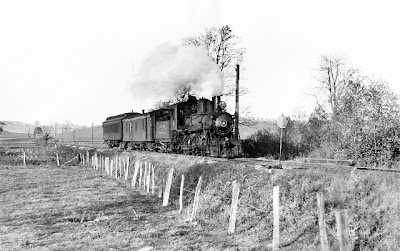"Midwest HO cork roadbed is about 18 scale inches high. Below it the width of the camper tape makes a proper sub roadbed. How will this height of cork relate to Ma & Pa practice? Check the photos in Hilton, specially page 97. Should the cork be eliminated and the flex track go directly on the camper tape?
Dick Bradley"
If you look at some of the pictures in Hilton's book, especially the one on page 97, it sure looks to be the Ma & Pa's practice to lay track almost on level ground with barely any drainage considerations. I've been working on the assumption that there had to be some elevation, even if it's not as much as other class one railroads. In fact I've been making my assumptions based on the Maryland & Pennsylvania RR Plan Book Vol. 2 that I purchased from the society.
Pages 72 and 73 show M&P standards for both crushed stone and cinder ballast and track profiles. If you go by a tie thickness of 7" it looks to be 7-9" of stone or cinder under the ties. Does this mean the Ma & Pa stood by what could be a best case scenario as far as how they actually kept their roadbed? Again, going by the picture on page 97 in Hilton's book and a lot of others, probably not. But take a look at some of the following pictures and you will see some semblance of a raised profile on some sections of the railroad..
 |
| #6 Bryansville pa. Stone ballast and a slight height difference can be seen. |
 |
| #6 Pylesville Maryland, a raised embankment is very noticeable here. |
 |
| #62 backing down the Dallastown Branch, again, a raised profile with decent stone ballast roadbed is evident. |
I think once I start adding the slight dips and scenery contours to the layout (remember I only have flat styrofoam down at the moment) you'll see that most of the scenery will at least be level at track side with the top of the camper tape, and any height variation will be where there is cork.
In the yard at York everything will defintely be flat. I bought sheets of cork to use in the yard, and the track will look like yard trackage, oil, dirt, grime, just the hint of what used to be cinder ballast.. You get the picture.
Thanks to Dick for making me go back and evaluate what I'm doing here. I value his input and he's turning out to be a good Devil's advocate and keeping me honest. :)
Also, thanks to the photographer's who's work I've used as examples above. If anyone knows who's pictures these are (Charles T Mahan maybe?) I'd like to give them proper credit.
Epiloge: Dick Bradley came up with the name of the photographer of the prototype photos. Here is what he said:
"Hi Ted: The photos of #6 at Bryansville and at Pylesville were taken by Wm. Moedinger, Jr. and most recently appeared in the Summer 2010 issue of the Ma&Pa "Timetable"
The photo of the train backing up the Dallastown branch is of a steam engine, a baggage/mail and a coach. It is not # 62. I suspect it was taken by Wm.Moedinger and is the same train seen in the other photos." Dick Bradley
Thanks Dick for the photo info!




One way to have a lower cork profile in Ho is to use three strips of N cork side by side with the middle one upside down. This gets the roadbed down to about nine inches thick. A rasp along the edge of the cork easily reduces the slope.
ReplyDeleteDick Bradley
That's a good idea. I'm going to try that out and see how it looks. Thanks Dick. :)
ReplyDelete